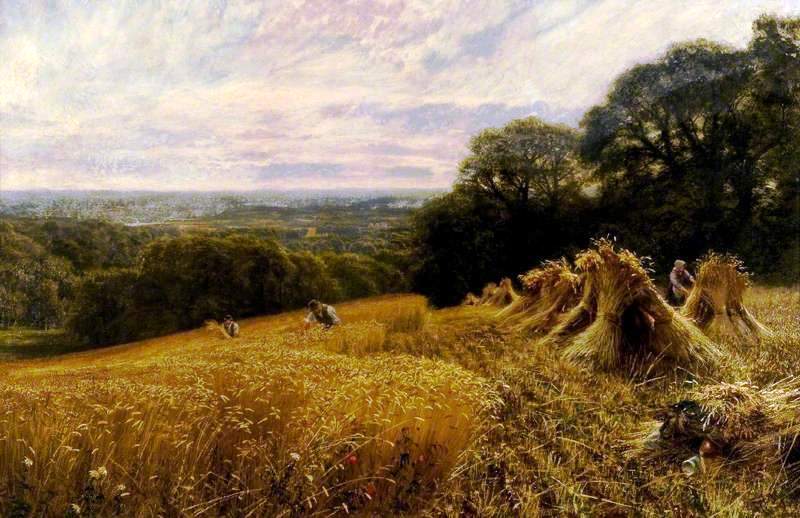
A Harvest Field by George Vicat Cole (1890) Glasgow Museums via BBC-Your Paintings http://www.bbc.co.uk/arts/yourpaintings/paintings/a-harvest-field-83551
Church and Chapel were always the warp and the weft, the yin and the yang of village life. A fellow blogger puts it thus:
Church or Chapel? It was an important question, for it defined the social circle we would be joining, our emotional support team, and ultimately our chances of salvation. The Church of England and the Methodist Chapel were the two places of worship in the village, one the establishment religion and the other dissident. The chapel stood at one end of the one street in the village, and the church was firmly at the other end. The blacksmith’s shop, with its fiery orange furnace, the heavy clink of hammer on anvil and the burning smell of sizzling horses’ hooves, stood right in the centre.
Nonconformism was a strong force in the Bourne Valley. And here Alison Deveson explains the relationship between the Primitive Methodists of St Mary Bourne and the Wesleyan Methodists of Whitchurch:
Whitchurch…began to face potential competition in the 1830s from a group of Primitive Methodist evangelists. The Primitive movement had begun in an area on the border between Staffordshire and Cheshire early in the century, as a religious revival by a number of Methodists who were dissatisfied with conventional Wesleyan Methodism…In 1830 a Primitive evangelist called Thomas Russell crossed from Berkshire to Hampshire, and, beginning at Combe and Faccombe, began to move down the Bourne Valley as far as St Mary Bourne, preaching and establishing small Primitive societies as he went.
Church had the advantage of establishment – they already had a building and a degree of momentum. But Chapel had its own way of winning the tug of war for hearts and minds. Mindful of the adage that the way to a [hu]man’s heart is through his or her stomach, the Primmers as they were nicknamed struck a low blow by recruiting the redoubtable Mrs Fisher to their number.
Take Harvest Festival, for example.
The ladies are not listed alphabetically, as a diplomatic local correspondent might consider it prudent to do, but with Mrs Fisher leading her two cohorts and her daughter bringing up the rear as if to emphasise the line of command.
 The reason is not hard to seek. The Fishers lived at Fourways, the house in the centre of the village next to the George Inn. The Kelly’s Trade Directory lists Henry Fisher as the proprietor of these ‘refreshment rooms’, but the 1911 census probably comes nearer the truth when it says that Mr Fisher is a wood dealer, and Mrs Fisher is ‘engaged in refreshment.’
The reason is not hard to seek. The Fishers lived at Fourways, the house in the centre of the village next to the George Inn. The Kelly’s Trade Directory lists Henry Fisher as the proprietor of these ‘refreshment rooms’, but the 1911 census probably comes nearer the truth when it says that Mr Fisher is a wood dealer, and Mrs Fisher is ‘engaged in refreshment.’
I think it is safe to say that Mrs Fisher probably refreshed the parts that other forms of ministry found it hard to reach, and that is with nothing more alcoholic than ‘the cup that cheers’, as it says in the piece, ‘but does not inebriate’.
For Mrs Fisher was Sarah Jane Goodyear Fisher, and the Goodyears’ claim to the village by virtue of length of descent would have bolstered her self-confidence.
She is correctly described as Mrs H[enry] Fisher, not Mrs Sarah Fisher, so we must assume that Mrs J Cook was the wife of John Cook, a self-employed farmer, and Mrs A Goodyear may have been Mrs Alfred William Goodyear, a plate-layer on the railway (or Mrs Alfred John, Mrs Albert….).
Notes
– I ‘inherited’ the photograph of the Swampton chapel amongst several others of the village and unfortunately do not know the owner. If it is yours, please contact us in the comments below so we can either acknowledge you or, if you prefer, remove the photograph.
– David Young writes about the Stoke (as opposed to the Swampton chapel above) Primitive Methodist Chapel on this page, where you can see a photograph:
Stoke (called “Stokebourne”) appears in 1834-5 in the Andover Branch of the Shefford Circuit.
Here are some figures recording the number of full society members at Stoke, extracted from the Andover Circuit account book:
1837 14; 1838 17; 1850 9; 1852 13
A site for a new chapel was acquired in 1864. A local preacher (who gave me the photograph) told me the chapel closed in 1973. It has since been demolished.
It seems from the above that the first paragraph of the Andover Advertiser article refers to the Stoke chapel, and the second paragraph refers to the one in Swampton, shown on the left hand side of this map.






